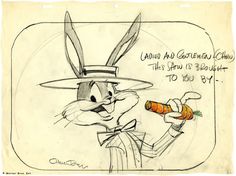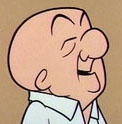 Chuck Jones Says. Here are some notes I took of Chuck Jones talking at the San Diego Comic Con 1982: “All characters come from within yourself. Lurking within everybody is a certain amount of Daffy Duck. Hopefully, some of Bugs Bunny, since that’s who you’d like to be. Pepe le Pew represents the way I always wanted to be with girls and never had the courage to be. Life is comprised of mistakes and humor is built on mistakes.
Chuck Jones Says. Here are some notes I took of Chuck Jones talking at the San Diego Comic Con 1982: “All characters come from within yourself. Lurking within everybody is a certain amount of Daffy Duck. Hopefully, some of Bugs Bunny, since that’s who you’d like to be. Pepe le Pew represents the way I always wanted to be with girls and never had the courage to be. Life is comprised of mistakes and humor is built on mistakes.
“The big difference between the Coyote and Bugs Bunny is the Coyote never wins. Never. He’s out to get a bird that wouldn’t even make a good meal. When you are making a character, decide whether you’re dealing with a clown or an actor. Clowns are best shown in circuses because they wear funny costumes. It’s not the way they move that makes them funny; it’s the way they look. People often call our stuff ‘realistic’ which is absurd. Nobody’s ever seen a rabbit that looked like Bugs Bunny.”

Nightmare Music. For Disney’s The Nightmare Before Christmas (1993), composer Danny Elfman was told by Burton to write the music with the feel of an old three penny opera. “It was our dismal sides that first brought us together,” Elfman told Adweek magazine in October 1993. “The only difference between us is that Tim’s hero growing up was Vincent Price. Mine was Peter Lorre. Price was always the torturer; Lorre was the persecuted.
“I actually sought a style for the music for the film that was somewhere between Rodgers and Hammerstein and Gilbert and Sullivan. I wanted to turn the clock backward and forward at the same time so that musically it feels fresh but is rooted in certain traditional styles.”
Elfman at that point had collected skeleton imagery for twenty-two years. His home was adorned with Day of the Dead artifacts and images, as well as a real shrunken head from Eucador. “So it was not like a major stretch for me to relate to Jack Skellington,” said Elfman.
Nightmare Music Part Two. In USA Today newspaper from October 1993, composer Danny Elfman talked about doing the music for The Nightmare Before Christmas (1993). “The first thing I told Disney is that there weren’t going to be any pop songs,” stated Elfman. “That was exactly what we wanted to get away from. The songs are more classical musical. For this film, my influences are Kurt Weill to Rodgers and Hammerstein with a little bit of Gilbert and Sullivan. The music was written before the script.
“Tim and I would just start to talk through a scene and I’d start to hear a melody in my head. Then I’d shoo him out of the room because I didn’t want to lose it. I’d call him three days later and play him the new songs. My daughter Molly (who was seven years old at the time) heard all of them first. She had to sign off on all of them. My test was if she could sing the melody back. In any good musical that I respected, the melodies carry with you.”
 How did Mike Judge come up with the design for the character of Butt-head? According to a statement he gave to the L.A. Times newspaper in 1993: “I was trying to draw a guy I went to high school with. I had drawings of him in an old school notebook of mine. It didn’t really look like him but I thought it was funny anyway. So, I kept drawing it like that. I thought ‘What if I just completely cut loose and make it look really awful?’ That is why the character looks the way he does. I put them (Beavis and Butt-head) in a short called Frog Baseball that MTV bought for its Liquid Television program. They decided to make it into a half hour series and ordered thirty-five episodes. My first thought was not elation but ‘I can’t even think of one more thing these guys could do’.”
How did Mike Judge come up with the design for the character of Butt-head? According to a statement he gave to the L.A. Times newspaper in 1993: “I was trying to draw a guy I went to high school with. I had drawings of him in an old school notebook of mine. It didn’t really look like him but I thought it was funny anyway. So, I kept drawing it like that. I thought ‘What if I just completely cut loose and make it look really awful?’ That is why the character looks the way he does. I put them (Beavis and Butt-head) in a short called Frog Baseball that MTV bought for its Liquid Television program. They decided to make it into a half hour series and ordered thirty-five episodes. My first thought was not elation but ‘I can’t even think of one more thing these guys could do’.”
I was unable to find any information about Williams at Disney but assume he was one of many artists drawn to the Disney Studio in the late 1930s as part of their aggressive campaign to hire animators and then he was probably drafted. Since he never popped up at another animation studio, I assume he was only casually interested in animation and went to Disney because they were the only place really hiring artists during the Depression.
There are many animators who had a long career in animation but never achieved “star” status. For instance, Allen Austin Wade was born in Arkansas City, Kansas and was hired in 1944 by Disney to work in the Donald Duck unit. His first assignment in feature films was Song of the South.
After four years in the Air Force, Wade found work at Warner Brothers, Hanna-Barbera, Filmation and UPA where he worked on the Mr. Magoo series for more than five years before he passed away at the age of 68 in 1993 in Burbank. And that’s all that I know about him. Just another journeyman animator.
 Leo is Magoo. According to his October 1993 obituary in Variety trade newspaper, “Leo Salkin wrote and directed the Disney short film Pigs Is Pigs, which earned an Oscar nomination and later won a Cine Golden Eagle Award for his short film Body Ego Technique. In 1975, he directed and animated the 2000 Year Old Man skit performed by Mel Brooks and Carl Reiner. It was Salkin’s physical appearance that provided the blue-print for animator John Hubley’s cartoon character Mr. Magoo, rather than the originally intended W.C. Fields.”
Leo is Magoo. According to his October 1993 obituary in Variety trade newspaper, “Leo Salkin wrote and directed the Disney short film Pigs Is Pigs, which earned an Oscar nomination and later won a Cine Golden Eagle Award for his short film Body Ego Technique. In 1975, he directed and animated the 2000 Year Old Man skit performed by Mel Brooks and Carl Reiner. It was Salkin’s physical appearance that provided the blue-print for animator John Hubley’s cartoon character Mr. Magoo, rather than the originally intended W.C. Fields.”
“There was a remarkable similarity between the two,” said Salkin family friend Ron Diamond. “Leo was kind of a short, bald fellow whose eyes seemed to squint a lot. But he wasn’t forgetful like Mr. Magoo.”
How many people know that Salkin wrote a book, Story-Telling Home Movies: How to Make Them (McGraw-Hill, 1958)?



 Jim Korkis is an internationally respected animation historian who in recent years has devoted his attention to the many worlds of Disney. He was a columnist for a variety of animation magazines. With his former writing partner, John Cawley, he authored several animation related books including The Encyclopedia of Cartoon Superstars, How to Create Animation, Cartoon Confidential and Get Animated’s Animation Art Buyer’s Guide. He taught animation classes at the Disney Institute in Florida as well as instructing classes on acting and animation history for Disney Feature Animation: Florida.
Jim Korkis is an internationally respected animation historian who in recent years has devoted his attention to the many worlds of Disney. He was a columnist for a variety of animation magazines. With his former writing partner, John Cawley, he authored several animation related books including The Encyclopedia of Cartoon Superstars, How to Create Animation, Cartoon Confidential and Get Animated’s Animation Art Buyer’s Guide. He taught animation classes at the Disney Institute in Florida as well as instructing classes on acting and animation history for Disney Feature Animation: Florida.




















































I actually remember checking out Salkin’s book from the library as a kid. Much of it was about shooting and editing 8mm home movies so they made sense (establishing shots, showing people in contexts, etc.). There was a storyboard for an animated public service film about annual checkups, but no Disney art.
That book can be found on archive.org if anyone’s curious to check it out.
I don’t know if this helps, but noodling around on ancestry.com shows that Allen Austin Wade was born December 31, 1924 in Arkansas City, Kansas, and apparently died August 14, 1993, in North Hollywood, California. He was the son of Charles Wade and his wife Blanche (nee Butler). I’ve seen his entries in the 1930 and 1940 censuses. According to publicly available family trees on ancestry.com, Wade was married twice, once in 1954, and again in 1961.
I’m not sure why I can’t find any records from the World War II period; it’s curious that he would have been hired by Disney at age 19. The census reports do suggest that he was an only child, and an only son, which may explain things. His father died not longer before, meaning he might have been his mother’s only support.
I read your comments regarding Alan Wade, for me he was Uncle Alan. When I was a kid he would bring over old movies such as Frankenstein and show them on a projector. Aunt Blanche was my grandmothers sister. My mother and my Aunt Alpha were with Uncle Alan shortly before he passed away in Burbank. Uncle Alan also did some animation for the Flintstones, thanks for your research, I am sure he would have appreciated it.
It’s frustrating to not know what happened to Bill Williams. He was one of the artists on the Dennis the Menace comic book from 1972-1980. Lambiek states that he was born on November 30, 1917, but I am not sure if he’s still alive. Of course, he would be 99 if he was. Craig Yoe claims that Williams has passed, but he doesn’t know when that was. If you find out anything else, please let me know.